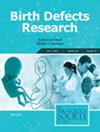Association Between Prenatal Exposure to Traffic-Related Air Pollution and Orofacial Clefts Among Newborns in New York State, Excluding New York City (2000–2019)
Abstract
Background
Prenatal exposure to tobacco smoke is strongly associated with the development of orofacial clefts. Traffic-related air pollution (TRAP) has many of the same toxic combustion byproducts as burning tobacco, such as benzene and PM2.5, and may therefore act through similar pathways to cause harm to developing fetuses. Since concentrations of TRAP are highest close to the roadway, they can be assessed using distance-weighted traffic density (DWTD).
Methods
A case–control study of birthing parent–newborn pairs was conducted among children born between January 1, 2000, and December 31, 2019, to people residing in New York State (NYS), excluding New York City. Cases of cleft lip alone, cleft palate alone, and cleft lip with cleft palate were identified from the NYS Birth Defects Registry. Orofacial clefts were also analyzed as an aggregated group. Controls without diagnosed major birth defects were randomly selected from hospital discharge records. DWTD measured in vehicles per day (VPD) was calculated from NYS Department of Transportation traffic data. A multivariate logistic regression model, adjusted for the birthing parent's age, race, ethnicity, and census tract-level disadvantage, was constructed to evaluate the association between orofacial clefts and DWTD.
Results
There was a statistically significant adjusted odds ratio (aOR) comparing the DWTD ≥ 500 VPD group to the DWTD reference group (< 500 VPD) found only among orofacial clefts as an aggregate group (aOR = 1.13 [1.04–1.22]).
Conclusions
The current study, covering 20 years of case collection, generally supports the DWTD's potential risk for orofacial clefts. Larger observational studies are warranted to further investigate associations between DWTD and individual categories of orofacial clefts.

 求助内容:
求助内容: 应助结果提醒方式:
应助结果提醒方式:


